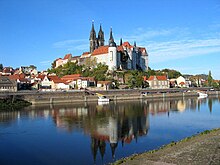Saxon Elbland
The Saxon Elbland is a cultural landscape in Saxony . It lies on both sides of the Elbe river , which gives it its name , partly on its upper reaches ( Saxon Switzerland , Eastern Ore Mountains , Dresden Elbe Valley and Meißner breakthrough valley ), partly on the middle course ( Central Saxon Loess Hill Country and Grossenhainer Pflege as well as Elbe-Elster Lowlands). Well-known cities in this area are Pirna , Dresden , Radebeul , Meißen , Riesa and Torgau .
History and demarcation
Historically, the Elbland corresponds to the core area of the medieval Mark Meißen or from 1547 to the Meißnische Kreis of the Electorate of Saxony . At that time, “Meissen” not only referred to the city, but also to the surrounding country. Since this area formed the political and cultural center of Saxony, the “real Saxony”, there is no need for demarcation and therefore no independent regional identity as “Meißner” or “Elbländer” - unlike in Upper Lusatia , the Ore Mountains or Vogtland “Developed. The residents identify themselves simply as Saxons and as residents of their respective village or town. The designation “Saxon Elbland” can already be found in Alfred Hettner's 1907 , but was hardly widespread in the general language and has only become more widely used since the 1990s.
The Saxon Elbland is bordered in the south by the state border with the Czech Republic (former Bohemia ). In the east, the rivers Pulsnitz and Schwarze Elster demarcate it from Upper Lusatia, which differs significantly from the rest of Saxony in historical and cultural terms. Brandenburg borders in the north , whereby the area around Mühlberg / Elbe , Elsterwerda and Ortrand can still be counted as part of the Saxon Elbland (this area belonged to the Meissnian district of Saxony until 1815 and only became part of Prussia and Brandenburg after the Congress of Vienna ). It is hardest to demarcate it to the west, because there is no clear separation there, neither in terms of landscape, geography, nor in terms of history and politics. Both the history (belonging to the Meißnischer Kreis) and the Meißen dialect speak in favor of the area around Oschatz being part of the Elbland.
From a political and administrative point of view, the Saxon Elbland has essentially comprised the districts of Meißen , Saxon Switzerland-Eastern Ore Mountains and the state capital Dresden as well as smaller parts of the districts of Bautzen , Central Saxony and Northern Saxony since the district reform in 2008 . In the course of the district reform there was talk of naming today's district of Meißen “Elbland”, but this did not take hold.
Regional cooperation
Major parts of the Saxon Elbe region - the districts of Meißen and Saxon Switzerland-Eastern Ore Mountains and the state capital Dresden - belong to the planning region of the Upper Elbe Valley / Eastern Ore Mountains Regional Planning Association . These are also part of the German-Czech Euroregion Elbe / Labe . In addition, the Elbland largely coincides with the tariff area of the Upper Elbe Transport Association (only the westernmost parts, around Torgau and Oschatz, belong to the Central German Transport Association ).
From the 1990s to 2017 there was a tourism association called Sächsisches Elbland. However, this was renamed the "Tourismusverband Elbland Dresden" and has since appeared under the brand name "Dresden Elbland". The members of the association include a the district of Meißen, the cities of Dresden, Meißen, Radebeul, Coswig , Großenhain and the municipality of Moritzburg .

In the area of wine industry, the landscape is characterized by one of the north-easternmost wine - growing regions in Europe. On the southern slopes rechtselbischen at Dresden- Pillnitz and between Radebeul and Elbweindörfern to Diesbar-Seußlitz is Saxon Wine grown. This makes up less than 1% of the total wine volume in Germany.
A philharmonic orchestra, the Elbland Philharmonie Sachsen , is named after the Saxon Elbland . It is based in Riesa, but also performs regularly in Radebeul, Meißen, Pirna, Großenhain and Rathen . The situation is similar with the state theaters of Saxony : They have their headquarters in Radebeul, but also run the Rathen rock stage and make guest appearances at numerous other locations in the Elbe region and all of Saxony.
Footnotes
- ^ Matthias Donath: Saxon Elbland. 2009, pp. 11-17.
- ^ A b Matthias Donath: Saxon Elbland. 2009, p. 7.
- ^ Matthias Donath: Saxon Elbland. 2009, p. 9.
- ^ Alfred Hettner: Fundamentals of regional geography. Volume I, Europe. Otto Spamer, Leipzig 1907, p. 363 ff.
- ↑ a b c Matthias Donath: Saxon Elbland. 2009, p. 8.
- ^ The planning region , Regional Planning Association Upper Elbe Valley / Eastern Ore Mountains, accessed on July 4, 2019.
- ^ Members , Tourismusverband Elbland Dresden e. V., accessed on July 4, 2019.
literature
- Matthias Donath : Saxon Elbland. Cultural Landscapes of Saxony, Volume 1. Edition Leipzig, Leipzig 2009, ISBN 978-3-361-00639-3 .
- Juliane Henze: Saxon Elbland. How it was back then. Bucher, Munich 2010, ISBN 978-3-765-81807-3


